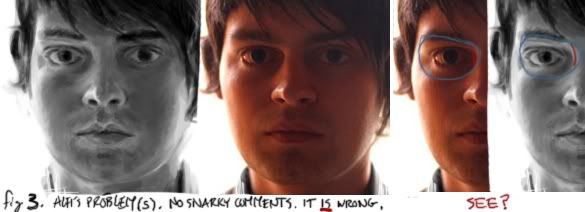 After the first sketch of the general shape of the head, the orbits (fig 1) and dark areas inside are the first thing I mark (fig 2).
After the first sketch of the general shape of the head, the orbits (fig 1) and dark areas inside are the first thing I mark (fig 2). So I was scribbling around the other day and I happened to finish off the shading in the orbit with a little line down the side where the nose was going to be. And I liked it. That's pretty much the sum of the discovery. (fig 3) That if I make this little line to mark the side of the nose I have a lot easier time seeing where the eyes are supposed to go in the grand scheme of things. See, I have this problem, I repeatedly make my eyes too small, too far apart, and crazy crooked. I think keeping better track of the nose, and the relationship of the eye to it, will help.
So I was scribbling around the other day and I happened to finish off the shading in the orbit with a little line down the side where the nose was going to be. And I liked it. That's pretty much the sum of the discovery. (fig 3) That if I make this little line to mark the side of the nose I have a lot easier time seeing where the eyes are supposed to go in the grand scheme of things. See, I have this problem, I repeatedly make my eyes too small, too far apart, and crazy crooked. I think keeping better track of the nose, and the relationship of the eye to it, will help.
Keeping proportions straight is just a matter of constantly checking on how each piece of face relates to another. I say 'just' like it's a simple thing. It's like rubbing your tummy, scratching your head and riding your bike with your pants down at your ankles (no, I'm not illustrating that). It's not just eye to nose, it's the pieces of face in between the parts we usually think about that really... connect everything. The spaces between the features are as much, or more important than the features themselves.

(Fig 4) This particular line reminds me of the relationship between the bridge of the nose (A), the eye/bridge valley where glasses rest (B), the connection of the upper-upper eyelid to the bridge of the nose (C), the nose edge of the third eyebag (D, you won't see this clearly on everybody), and the lump of the tear duct (E, something I often forget, I only just realized what I was looking at in this picture as I mapped it out again for this. Ridiculous. Thank god I figured that out, I was so confused what that lighter patch was doing).
It's all ratios and itty-bitty invisible lines with me. They say not to sweat the small stuff. But the big stuff terrifies me more anyway. I figure, if I get enough small stuff right, it'll add up to some good big stuff too. That's totally a fallacy, but it's only slightly worse than most sayings.

Today I've also been thinking about lips. (Fig 5, yes, that's the same picture.) Mostly I've been thinking that they're insane and I don't get why there would be a weird little ridge-y dip thing at the junction of the lip and face skin. What. The. Hell. I think I've almost got it, just let me sleep on it.




 g
g  s)
s)


